Unit 8 Helping at home 第三课时教学文字实录.docx
《Unit 8 Helping at home 第三课时教学文字实录.docx》由会员分享,可在线阅读,更多相关《Unit 8 Helping at home 第三课时教学文字实录.docx(8页珍藏版)》请在冰豆网上搜索。

Unit8Helpingathome第三课时教学文字实录
Unit8:
Helpingathome第三课时教学文字实录
一.课程概况:
I.内容:
Unit8:
Helpingathome
II.源自:
四年级开心英语上册
III.课型:
语音课
二.教学过程(课堂实录):
I.Greetingandwarmingup(2’)
Step1:
Greeting
T:
Goodafternoon,everyone!
S:
Goodafternoon,Kim!
T:
Sitdown,please!
S:
Thankyou,Kim!
T:
One,two,three!
S:
A,B,C!
Step2:
Presentthetitleandintroducethegroupcompetitionmechanism
T:
Ok,boysandgirls,todaywe’aregoingtolearnUnit8Helpingathome“Soundsandwords”.Now,let’shavealook,wehavetwoteamstoday.Therearetwobeeshere..Whatcoloristhisbee?
S:
It’sagreenbee.
T:
OK!
Greenbeeforboys.Andwhataboutthisone?
S:
It’sapinkbee.
T:
Good!
Pinkbeeforgirls.Areyouclear?
S:
Yes!
T:
OK!
Let’shaveamatchtoday.
S:
Yes!
[设计意图]:
将小蜜蜂“bee”作为教学中的主线,通过我能说,我能读,我能写三个不同层次的飞跃帮助小蜜蜂得到蜂蜜。
男生是绿色蜜蜂组,女生是粉色蜜蜂组。
Ⅱ.Review(2’)
T:
Ok,Boysandgirls,Let’scheckhomework..Look,thisispictureA,andthisispictureB.PleasefindthedifferencebetweenpictureAandpictureB.OK?
S:
Yes.
T:
Forexample,inpictureA,whatisGogodoing?
IsGogosinging?
S:
No.
T:
IsGogodusting?
S:
Yes.
T:
OK.InpictureA,Gogoisdusting.WhatisGogodoinginpictureB?
S1:
Sweepingthefloor.
T:
Good.Sowecansay:
InpictureA,Gogoisdusting,butinpictureB,Gogoissweepingthefloor.Now,whocansaysomethingaboutTony?
S2:
InpictureA,Tonyisfoldingtheclothes,butinpictureB,Tonyissleeping.
T:
Excellent!
Followme,“old-fold-folding-foldingtheclothes.”
S:
Old-fold-folding-foldingtheclothes.
T:
Good,WhataboutMum?
Canyoumakeasentence?
S3:
InpictureA,Mumiscooking,butinpictureB,Mumiswashingthedishes.
T:
Youdidverygoodjob!
Ok,thelastone,whatisLisadoing?
S4:
InpictureA,Lisaisplaying,butinpictureB,Lisaissinginganddancing.
T:
Good!
Onestepforyou.
[设计意图]:
利用找不同的游戏复习上节课所学内容,巩固知识点。
Ⅲ.Presentation(5’)
Step1:
Leadin
T:
OK!
Thisisourhomework..Now,let’shavearelax,singasongtogether.Areyouready?
S:
Yes.
T:
Thealphabetsong.
S:
IknowtheletterAsays….
T:
Youdidagoodjob!
Look,Whohasbigeyes?
Pleasereadtheseletters.?
S:
U
T:
Andthisone?
S:
A
...(边复习元音字母边画图,利于学生理解)
T:
OK!
Todaywe’regoingtolearnthepronunciationof“ee”.
[设计意图]:
进行语音教学前,齐唱歌曲让孩子们对26个字母的发音先热身。
然后教师通过卡通图片复习a,e,i,o,u五个元音字母并巧妙的将五个元音字母组合成一个脸谱从而引出本节课新授知识点。
T:
Now,boysandgirls,Look,What’sthis?
S:
It’sabee.
T:
Good,lookatmymouth,“ee”says/i:
/.Followme,/i:
/.
S:
/i:
/.
T:
Thisisalittlebee,hewantstogetsomehoney.Canyouhelephim?
S:
Yes.
[设计意图]:
本环节中的蜜蜂单词“bee”既是新授的一部分,又是整堂课的主线。
通过对小蜜蜂的帮助让学生对将要完成的学习任务有一个心理准备。
这个任务型活动的创设可以自然地激发起学生的助人为乐的精神与求知欲。
Step2:
Icansay
T:
OK!
Let’sfly,areyouready?
S:
Yes.
T:
Look,whatarethese?
S:
Feet.
S:
“ee”says?
T:
/i:
/.
S:
Iknowtheletter“F”says...
T:
/f/,/f/,/f/.
T:
Andthelastletteris...
S:
/T/.
T:
Followme,feet.
S:
Feet.
(Showstudentsthepictureoftree,green,sleep,sweepandguideSstosaythewords.)
T:
Pleasereadallofwordstwice,one,two,go.
S:
Feet,feet...
T:
Youdidaverygoodjob!
[设计意图]:
采取“直观教学法”,让学生感知、体验,自己总结出字母组合“ee”在单词中的发音规律,为接下来的学习内容做铺垫。
Step3:
Icanread
T:
Ok,boysandgirls,thelittlebeewantstoflyagain.Le’sfly!
S:
Yes!
T:
Now,it’sourstorytime.ThestoryisaboutPete’ssheep.Youcantakeoutyourpaperandreadthestory“Pete’ssheep”,andthencirclethewordsabout/i:
/accordingtothestory.Forexample,“sheep”.OK?
(Showthemthemaincharacterofstory.Thenaskthemtoreadthestoryandfinishtheexercises.)
S:
OK.
T:
Areyoufininshedit?
S:
Yes.
T:
Good!
Now,let’slistentothestoryandchecktheanswers.
...
T:
Canyoufindthewordsabout/i:
/accordingtothissentence?
S:
Sleep.
T:
Canyoureadthissentence?
S1:
Petecannotsleep.Sleep.
T:
Good,onestepforyou.Andnextone,whocanhaveatry?
S2:
Needs,Peteneedshelp.
T:
Yes,Iknowtheletter“N”says...
S:
/n/,/n/,/n/.
T:
Followme,need.
S:
Need.
T:
Needs.
S:
Needs.
T:
Peteneedshelp.
S:
Peteneedshelp.
(Readthesentencesonebyone,thenchecktheanswers.)
T:
Welldone.Thesheeprunpastthetree.Whowantstobeatree?
S1:
Iwanttotry.
T:
OK!
Comehere.YouareatreeandI’masheep.
T:
Doyouknowwhat’sthemeaningof“past”?
S:
Yes.
T:
OK!
ThisisastoryaboutPete’ssheep.Whocanreadallthewordsaboutthisstory?
S1:
Sheep,sleep,need,three,see,tree.
T:
Whowantstotryagain?
S2:
Sheep,sleep,need,three,see,tree.
T:
Excellent!
Now,pleasereadthewordswithyourpartner,andthenfillintheblanks.
S:
...
T:
Let’shaveabingogame!
Whoisthefirstonetosaybingoandyoucananswerthequestion,OK?
S:
OK.
T:
Groupthree.
S1:
Bingo!
“Thinkofsheep”saysMum..
T:
Good.
...
[设计意图]:
本环节采用的教学方法是启发式教学法。
通过第一阶段对本节课新授知识的认知与小结:
字母组合“ee”在单词中的发音规律,从而在故事中帮助学生将本课的信息进行加工、储存,从而明确教学目标、重点和难点。
Step4:
Icanwrite
T:
Thelittlebeewantstoflyandfly.Now,pleaselistenandwrite.Takeoutyourpenandlistentomecarefully!
S:
OK!
A______anda______
A______is______ingundera______.
A______isdancingnearthe______’s______.
Phil______sthe______.
Phil______sthe______.
Philsaystohimself(他自己),
“Whatafunny______and______!
”
(Listentomethreetimesandwritethewordsincorrectplace.)
T:
Areyoufinishedit?
S:
Yes.
T:
Now,let’schecktheanswers.Youshouldchangeyourpaperwithpartner.
Asheepandabee
Asheepissleepingunderatree.
Abeeisdancingnearthesheep’sfeet.
Philseesthesheep.
Philseesthebee.
Philsaystohimself,
“Whatafunnysheepandbee!
”
T:
Good!
Whohasgotonehundredpoints?
Showmeyourhands,please!
S:
...
T:
Thistime,pleaselistenandrepeat.
S:
...
(Listentothetapeandchantafterbythetape,Payattentiontothepronunciationandtherhythm.)
T:
Canyoureaditbyyourself?
S:
Yes.
[设计意图]:
此环节是本节课的升华。
以学生为主体,重视学生学习方法的引导和学习习惯的养成。
通过歌谣锻炼学生的拼读与听写综合能力,让学生采用直呼式拼读法由“见词能读”上升到“听词能写”的高度。
Ⅳ.Activity:
Showtime
T:
Boysandgirls,I’dliketogiveyoufiveminutestoactthischant?
Look,I’masheep.Whowantstobeabeeandwhowantstobeeatree?
S1:
Letmetry!
S2:
Letmetry!
T:
Hello,I’masheep.(做示范:
带着学生表演一次)
...
T:
Now,pleasechantandactwithyourpartner.
S:
...
T:
One,two,three.
S:
A,B,C.
T:
Whowantstohaveashow?
S:
Letmetry.
(AskSstohavearoleplay!
)
S1:
Hello,I’masheep.
S2:
Hello,I’matree.
S3:
Hello,I’mabee.
S4:
Hello,I’mPhil.
S1234:
One,two,action!
Let’sreadastory“Asheepandabee”.
S:
Thankyou!
T:
Youdidaverygoodjob!
Whowantstotry?
S:
...
[设计意图]:
此环节采用的是TPR教学法。
学说chant不仅可以使知识变得简单、生动、印象深刻,而且通过说和演相结合的训练,真正将语音教学落到实处。
学生通过亲自参与体验和合作的方式更能激发学生学习的兴趣,不仅考察学生的分析与记忆能力,还使学生形成积极的学习态度。
Ⅴ.Summyandhomework(3’)
T:
Boysandgirls,thelittlebeegetshisfavoritehoney,thankyousomuch!
Today’shomeworkistrytomakeanewchantorstorywiththewordsontheblackboard.Ok?
S:
OK!
T:
Now,classisover,goodbye!
S:
Bye!
[设计意图]:
学生通过自己的努力帮助小蜜蜂得到了蜂蜜,这个阶段使学生获得了成就感。
家庭作业的设计目的在于:
在学生有了简单的英语基础知识和听说读写的能力基础上,尝试让学生初步自主探究,运用所学发音规律创造自己的歌谣,培养学生的创新能力。
[教学后记]:
本节课各教学环节衔接自然、层次清晰,教学目标明确,教学重点突出。
主要亮点如下:
一、教学过程体现了学生的主体性。
本节课我将小蜜蜂“bee”作为教学中的主线,通过“我能说、我能读、我能写”三个不同层次的飞跃帮助小蜜蜂得到蜂蜜。
这个任务型活动的创设可以自然地激发起学生的助人为乐精神与求知欲。
通过对小蜜蜂的帮助让学生对将要完成的学习任务有一个心理准备。
二、教学方法有针对性,能帮助学生形成有效的学习策略。
第一步:
“Icansay”采取“直观教学法”。
运用多媒体课件、单词卡片形象直观的教学手段,让学生感知、体验,自己总结出字母组合“ee”在单词中的发音规律。
第二步:
“Icanread”采用“启发式教学法”。
让学生在对本节课新授知识认知与小结的基础上,利用故事教学帮助学生将本课的信息进行加工、储存,从而明确教学目标、重点和难点。
第三步:
“Icanwrite”环节是本节课的升华。
以学生为主体,重视学生学习方法的引导和学习习惯的养成。
通过歌谣锻炼学生的拼读与听写综合能力,让学生采用直呼式拼读法由“见词能读”上升到“听词能写”的高度。
三、注重学生合作学习。
课堂的活动设计都是为了让学生学会通过彼此合作去互相学习,互相交流。
尤其是最后的showtime环节,采用的是TPR教学法。
学说chant不仅可以使知识变得简单、生动、印象深刻,而且通过说和演相结合的训练,真正将语音教学落到实处。
学生通过亲自参与体验和合作的方式更能激发学生学习的兴趣,不仅考察学生的分析与记忆能力,还使学生形成积极的学习态度。